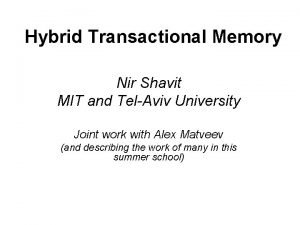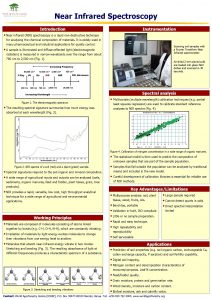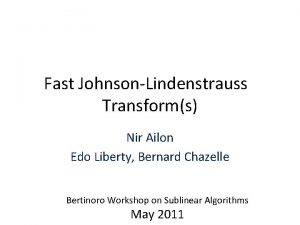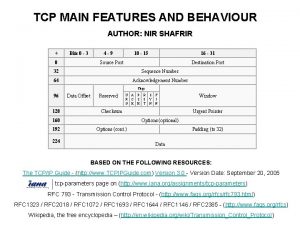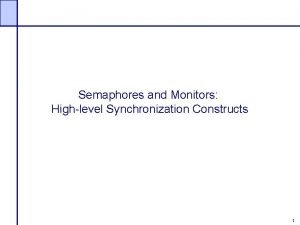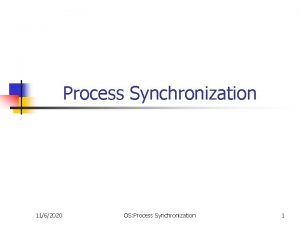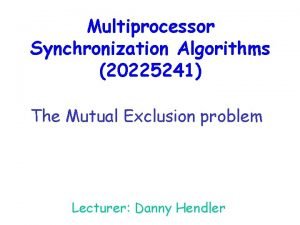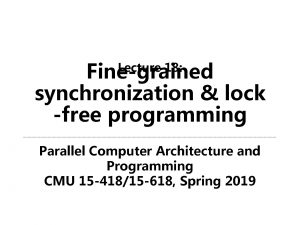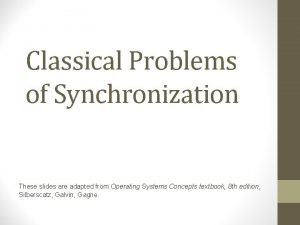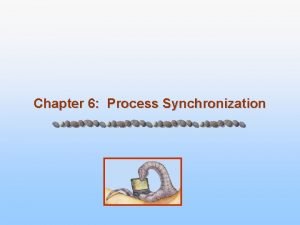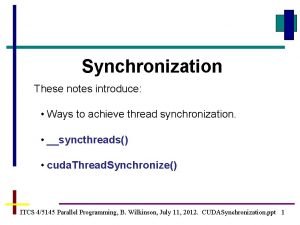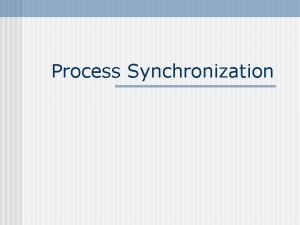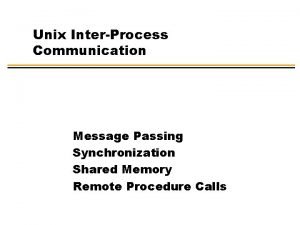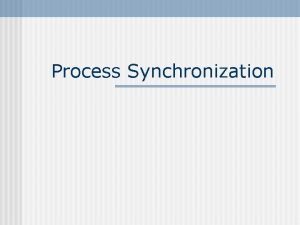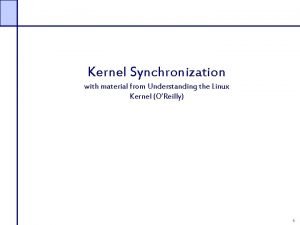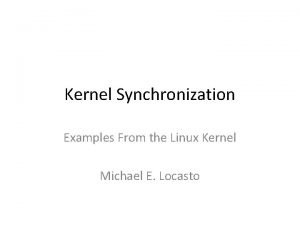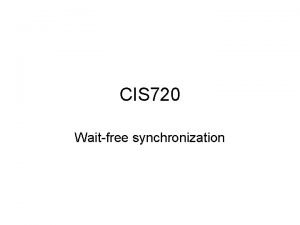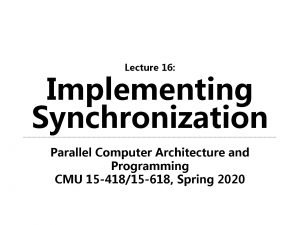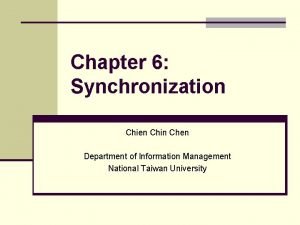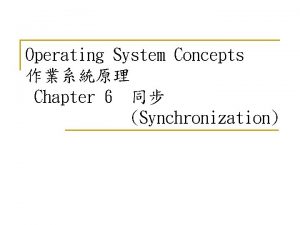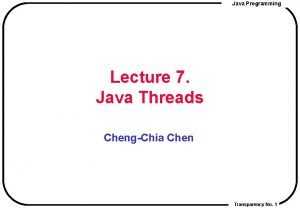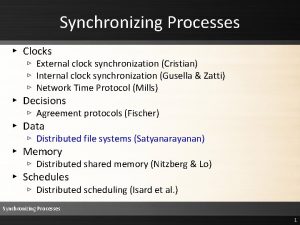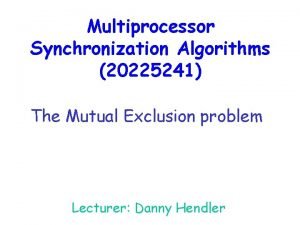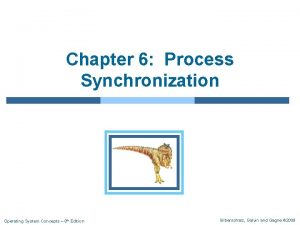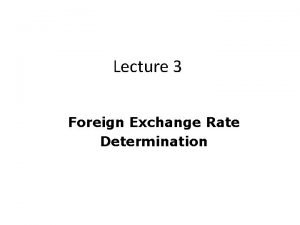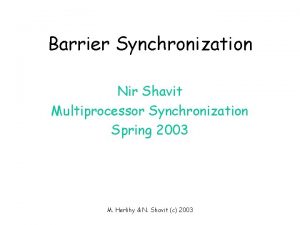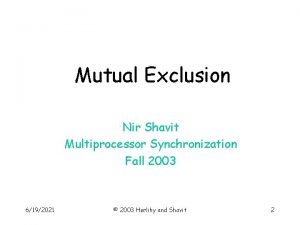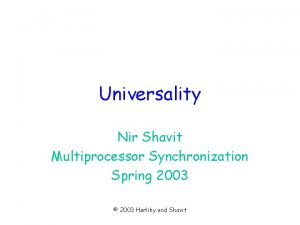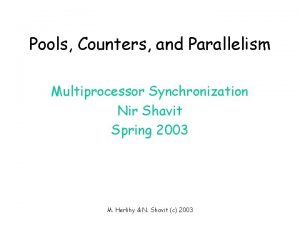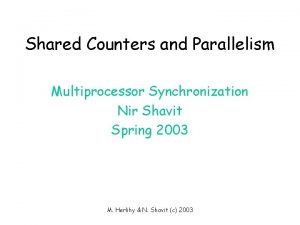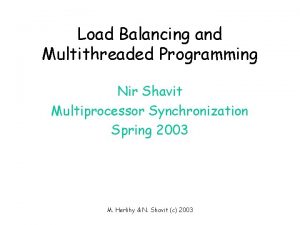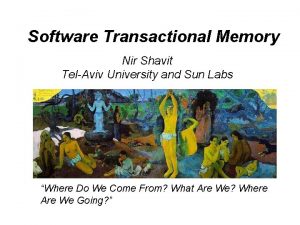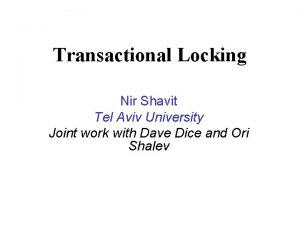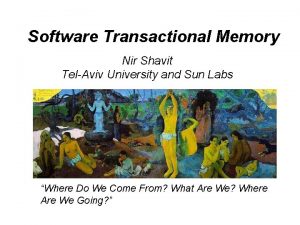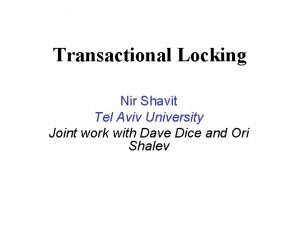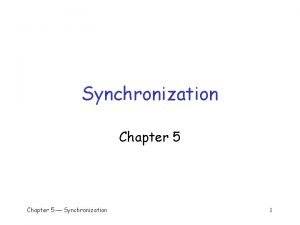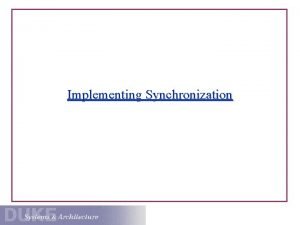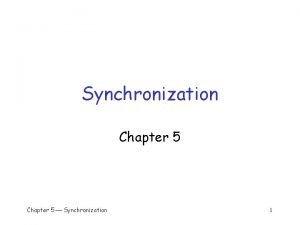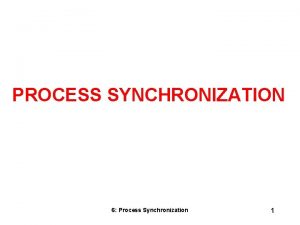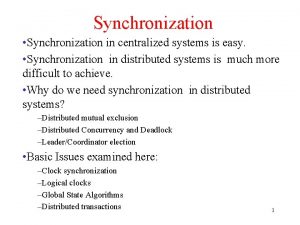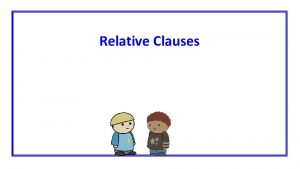The Relative Power of Synchronization Methods Nir Shavit
















































![The Consensus Object public abstract class Consensus implements Consensus { private Object[] announce; Always The Consensus Object public abstract class Consensus implements Consensus { private Object[] announce; Always](https://slidetodoc.com/presentation_image_h/bb5e70ba743a68d271c78687e78b32cf/image-49.jpg)



















































- Slides: 100

The Relative Power of Synchronization Methods Nir Shavit Multiprocessor Synchronization Spring 2003 11/29/2020 © 2003 Herlihy and Shavit 2

Wait-Free Implementation • Every method call completes in finite number of steps • Implies no mutual exclusion (2) © 2003 Herlihy and Shavit

Wait-Free Constructions • Wait-free atomic registers – From safe registers • Two-threaded FIFO queue – From atomic registers – And indirectly from safe registers © 2003 Herlihy and Shavit

Rationale • We wanted atomic registers to implement mutual exclusion • So we couldn’t use mutual exclusion to implement atomic registers • But wait, there’s more! © 2003 Herlihy and Shavit

Unexpected Delay ? ? ? Sw app bac ed ou t ka t 11/29/2020(2) © 2003 Herlihy and Shavit 6

Heterogeneous Architectures ? ? ? Pentium 11/29/2020(1) ? ? ? Pentium © 2003 Herlihy and Shavit yawn 286 7

Fault-Tolerance ? ? ? 11/29/2020(2) ? ? ? © 2003 Herlihy and Shavit 8

Basic Questions • Might be a good idea in principle • But how do you do it – Systematically? – Correctly? – Efficiently? © 2003 Herlihy and Shavit

Concurrent FIFO Queue 11/29/2020 © 2003 Herlihy and Shavit 10

Two-Thread Wait-Free Queue public class Wait. Free. Queue { int head = 0, tail = 0; Item[QSIZE] items; public void enq(Item x) { while (tail-head == QSIZE); // busy-wait items[tail++ % QSIZE] = x; } public Item deq() { while (tail == head); // busy-wait return items[head++ % QSIZE]; }} 11/29/2020 © 2003 Herlihy and Shavit 11

What About Multiple Dequeuers? 11/29/2020 © 2003 Herlihy and Shavit 12

Grand Challenge Only new • Implement a FIFO queue aspect – – Wait-free Linearizable From atomic read-write registers Multiple dequeuers (1) © 2003 Herlihy and Shavit

Consensus • While you are ruminating on the grand challenge… • We will give you another puzzle – Consensus – Pretty important … © 2003 Herlihy and Shavit

Consensus: Each Thread has a Private Input 32 19 © 2003 Herlihy and Shavit 21

They Communicate 11/29/2020 © 2003 Herlihy and Shavit 16

They Agree on Some Thread’s Input 19 19 © 2003 Herlihy and Shavit 19

Formally: Consensus Consistent: all threads decide the same value Valid: the common decision value is some thread's input Wait-free: each thread decides after a finite number of steps © 2003 Herlihy and Shavit

Theorem: No Consensus from Registers if any Thread can Halt ? ? ? © 2003 Herlihy and Shavit

Proof Strategy • Assume otherwise • Reason about the properties of any such protocol • Derive a contradiction • Quod Erat Demonstrandum © 2003 Herlihy and Shavit

Wait-Free Computation A moves B moves • Either A or B “moves” • Moving means – Register read – Register write © 2003 Herlihy and Shavit

The Two-Move Tree Final states (2) Initial state © 2003 Herlihy and Shavit

Decision Values 1 0 0 1 © 2003 Herlihy and Shavit 1 1

Bivalent: Both Possible bivalent 1 0 0 1 © 2003 Herlihy and Shavit 1 1

Univalent: Single Value Possible univalent 1 0 0 1 © 2003 Herlihy and Shavit 1 1

1 -valent: Only 1 Possible 1 -valent 1 0 0 1 © 2003 Herlihy and Shavit 1 1

0 -valent: Only 0 possible 0 -valent 1 0 0 1 © 2003 Herlihy and Shavit 1 1

Summary • Wait-free computation is a tree • Bivalent system states – Outcome not fixed • Univalent states – Outcome is fixed – May not be “known” yet • 1 -Valent and 0 -Valent states © 2003 Herlihy and Shavit

Claim Some initial system state is bivalent If A starts with input 0 and B starts with input 1, then initially A should be able to decide 0 and B should be able to decide 1. Lets see why? © 2003 Herlihy and Shavit

A 0 -Valent Initial State 0 0 • All executions lead to decision of 0 (2) © 2003 Herlihy and Shavit (1)

A 0 -Valent Initial State 0 • Solo execution by A also decides 0 (1) © 2003 Herlihy and Shavit (1)

A 1 -Valent Initial State 1 1 • All executions lead to decision of 1 (2) © 2003 Herlihy and Shavit (1)

A 1 -Valent Initial State 1 • Solo execution by B also decides 1 (1) © 2003 Herlihy and Shavit (1)

A Univalent Initial State? 0 1 • Can all executions lead to the same decision? (2) © 2003 Herlihy and Shavit

State is Bivalent 1 0 • Solo execution by A must decide 0 11/29/2020 • Solo execution by B must decide 1 © 2003 Herlihy and Shavit 35

Critical States critical 0 -valent (3) 1 -valent © 2003 Herlihy and Shavit (3)

Critical States • Starting from a bivalent initial state • The protocol can reach a critical state – Otherwise we could stay bivalent forever – And the protocol is not wait-free © 2003 Herlihy and Shavit

From a Critical State c 0 -valent If A goes first, protocol decides 0 1 -valent If B goes first, protocol decides 1 © 2003 Herlihy and Shavit

Model Dependency • So far, memory-independent! • True for – – Registers Message-passing Carrier pigeons Any kind of asynchronous computation © 2003 Herlihy and Shavit

What are the Threads Doing? • Reads and/or writes • To same/different registers © 2003 Herlihy and Shavit

Possible Interactions A reads x A reads y x. read() y. read() x. write() y. write() x. read() ? ? y. read() ? ? x. write() ? ? y. write() ? ? © 2003 Herlihy and Shavit

Reading Registers A runs solo, decides 0 c 0 1 States look the same to A B reads x n o i A runs solo, t c i decides 1 d a r t n o C © 2003 Herlihy and Shavit

Possible Interactions x. read() y. read() x. write() y. write() x. read() no no y. read() no no x. write() no no ? ? y. write() no no ? ? © 2003 Herlihy and Shavit

Writing Distinct Registers A writes y c B writes x A writesioyn B writes x 0 1 d a r t n o C same The song remains the © 2003 Herlihy and Shavit t ic

Possible Interactions x. read() y. read() x. write() y. write() x. read() no no y. read() no no x. write() no no ? no y. write() no no no ? © 2003 Herlihy and Shavit

Writing Same Registers A writes x c B writes x A runs solo, decides 0 A writes x 0 States look the same to A 1 d a A runs solo, decides 1 r t n o C © 2003 Herlihy and Shavit t ic n io

That’s All, Folks! x. read() y. read() x. write() y. write() x. read() no no y. read() no no x. write() no no y. write() no no © 2003 Herlihy and Shavit

Theorem • It is impossible to solve consensus using read/write atomic registers – – Assume protocol exists It has a bivalent initial state Must be able to reach a critical state Case analysis of interactions • Reads vs others • Writes vs writes © 2003 Herlihy and Shavit

What Does Consensus have to do with Concurrent Objects? 11/29/2020 © 2003 Herlihy and Shavit 49
![The Consensus Object public abstract class Consensus implements Consensus private Object announce Always The Consensus Object public abstract class Consensus implements Consensus { private Object[] announce; Always](https://slidetodoc.com/presentation_image_h/bb5e70ba743a68d271c78687e78b32cf/image-49.jpg)
The Consensus Object public abstract class Consensus implements Consensus { private Object[] announce; Always announce n) { intentions public Consensus. Impl(int announce = new Object[n]; } public void propose(Object value) { announce[Thread. my. Index()] = value; } abstract public Object decide(); }} (4) © 2003 Herlihy and Shavit Figure out which one won (4)

Can FIFO Queue Implement A Consensus Object? proposed array 8 FIFO Queue with red and black balls © 2003 Herlihy and Shavit

A Consensus Protocol Preferred array FIFO Queue with red and black balls 8 Coveted red ball Dreaded black ball © 2003 Herlihy and Shavit

Protocol: Write Value to Array 0 11/29/2020 0 © 2003 Herlihy and Shavit 1 53

Protocol: Take Next Item from Queue 0 8 0 11/29/2020 1 © 2003 Herlihy and Shavit 54

Protocol: Take Next Item from Queue I got the 0 coveted 1 red ball, so I will decide my value I got the dreaded black ball, so I will decide the other’s value from the array 8 11/29/2020 © 2003 Herlihy and Shavit 55

Consensus Using FIFO Queue public class Queue. Consensus extends Consensus { Queue queue; Initialize public Queue. Consensus() { Queue queue = new Queue(); queue. enq(“red ball"); queue. enq(“black ball"); } public Object decide() { i won String status = queue. deq(); int i = Thread. my. Index(); if (status == “red ball") i lost return proposed[i]; else return proposed[1 -i]; } © 2003 Herlihy and Shavit

Why does this Work? • • If one thread gets the red ball Then the other gets the black ball Winner can take her own value Loser can find winner’s value in array – Because threads write array – Before dequeueing from queue © 2003 Herlihy and Shavit

Implication • We can solve 2 -thread consensus using only – A two-dequeuer queue, and – A couple of atomic registers © 2003 Herlihy and Shavit

Implications • Given – A consensus protocol from queue and registers • Assume there exists – A queue implementation from atomic registers • Substitution yields: n o i t c i – A wait-free consensus protocol from atomic registers d a tr n o c (1) © 2003 Herlihy and Shavit (1)

Corollary • It is impossible to implement – a two-dequeuer wait-free FIFO queue – from read/write memory. © 2003 Herlihy and Shavit

Consensus Numbers • An object has consensus number n – If it can be used • Together with atomic read/write registers – To implement n-thread consensus • But not (n+1)-thread consensus © 2003 Herlihy and Shavit

Consensus Numbers • Theorem – Atomic read/write registers have consensus number 1 © 2003 Herlihy and Shavit

Consensus Numbers • Consensus numbers are a useful way of measuring synchronization power • Theorem – If you can implement X from Y – And X has consensus number c – Then Y has consensus number at least c © 2003 Herlihy and Shavit

Synchronization Speed Limit • Conversely – If X has consensus number c – And Y has consensus number d < c – Then there is no way to construct a waitfree implementation of X by Y • This theorem will be very useful – Unforeseen practical implications! © 2003 Herlihy and Shavit

Earlier Grand Challenge • Snapshot means – Write any array element – Read multiple array elements atomically • What about the dual problem: – Write multiple array elements atomically – Scan any array elements • Call this problem multiple assignment © 2003 Herlihy and Shavit

Multiple Assignment Theorem • No protocol – Using only read/write registers • Implements multiple assignment • Weird or what? – Single write/multiple read OK – Multi write/multiple read impossible – In fact: Multi write/single read also impossible!!! (1) © 2003 Herlihy and Shavit (1)

Proof Strategy • Given a 3 -element array – A writes atomically to slots 0 and 1 – B writes atomically to slots 1 and 2 – Any thread can scan any set of locations • Then we can solve 2 -consensus – So multiple assignment has consensus number at least 2 – No read/write register implementation © 2003 Herlihy and Shavit (1)

Initially A Writes to 0 and 1 B 11/29/2020 Writes to 1 and 2 © 2003 Herlihy and Shavit 68

Thread A wins if it sees A B 11/29/2020 © 2003 Herlihy and Shavit 69 (1)

Thread A wins if it sees A B 11/29/2020(1) © 2003 Herlihy and Shavit 70

Thread A loses if it sees A B 11/29/2020(1) © 2003 Herlihy and Shavit 71

Multi-Consensus class Multi. Consensus { Multi. Assign multi; Write/Scan locations public Object decide() { int i = Thread. my. Index(); // my index int j = 1 - i; // other index multi. assign(i, input, i+1, input); Object[] result = multi. scan(); if (result[(j + 1) % 3] == null || (result[j] == result[(j + 1) % 3])) return proposed[i]; Figure out else return proposed[j]; which one won } (4) © 2003 Herlihy and Shavit (4)

Summary • If a thread can assign atomically to 2 out of 3 array locations • Then we can solve 2 -consensus • Implying – No wait-free implementation – From read/write registers © 2003 Herlihy and Shavit

Read-Modify-Write • Method takes 2 arguments: – Variable x – Function f • Method call: – Returns value of x – Replaces x with f(x) © 2003 Herlihy and Shavit

Read-Modify-Write public abstract class RMW { private int value; Return prior value public void synchronized rmw(function f) { int prior = this. value; this. value = f(this. value); return prior; } Apply function f() } (1) © 2003 Herlihy and Shavit

Example: Read public abstract class RMW { private int value; public void synchronized read() { int prior = this. value; this. value = this. value; return prior; } f(v)=v is the identity function } (1) © 2003 Herlihy and Shavit

Example: test&set public abstract class RMW { private int value; public synchronized void TAS() { int prior = this. value; this. value = 1; return prior; } } F(v)=1 is constant function (1) © 2003 Herlihy and Shavit

Example: fetch&inc public abstract class RMW { private int value; public synchronized void FAI() { int prior = this. value; this. value = this. value+1; return prior; } f(v)=v+1 is increment function } (1) © 2003 Herlihy and Shavit

Example: fetch&add public abstract class RMW { private int value; public synchronized void FAA(int x) { int prior = this. value; this. value = this. value+x; return prior; } F(v, x)=v+x is the addition function } (1) © 2003 Herlihy and Shavit

Example: swap public abstract class RMW { private int value; public synchronized void swap(int x) { int prior = this. value; this. value = x; return prior; } F(v, x) = x is a constant function } (1) © 2003 Herlihy and Shavit

Example: compare&swap public abstract class RMW { private int value; public synchronized void CAS(int old, int new) { int prior = this. value; if (this. value == old) this. value = new; return prior; } f(old, new) is a complex function } (1) © 2003 Herlihy and Shavit

Definition • A RMW is non-trivial if there exists a value v Such that v ≠ f(v) • read is trivial • FAA is not © 2003 Herlihy and Shavit

Theorem • Any non-trivial RMW object has consensus number at least 2 • Implies no wait-free implementation of RMW registers from read/write registers • Hardware RMW instructions not just a convenience © 2003 Herlihy and Shavit

Reminder • All objects that inherit from Consensus have – propose method – which just stores input into this. announce[i] © 2003 Herlihy and Shavit

Proof Initialized to v public class RMWConsensus implements Consensus { private RMW r; Am I first? public Object decide() { int i = Thread. my. Index(); Yes, return if (r. rmw(f) == v) my input return this. announce[i]; else return this. announce[1 -i]; }} 11/29/2020(4) © 2003 Herlihy and Shavit No, return 85 other’s input

Proof • We have displayed – A two-thread consensus protocol – Using any non-trivial RMW object © 2003 Herlihy and Shavit

Interfering RMW • Let F be a set of functions such that for all fi and fj, either – They commute: fi(fj(v))=fj(fi(v)) – They overwrite: fi(fj(v))=fi(v) • Claim: Any such set of RMW objects has consensus number exactly 2 © 2003 Herlihy and Shavit

Examples • Test-and-Set f(v)=1 Overwrite fi(fj(v))=fi(v) • Swap f(v, x)=x Overwrite fi(fj(v))=fi(v) • Fetch-and-inc f(v)=v+1 Commute fi(fj(v))= fj(fi(v)) © 2003 Herlihy and Shavit

Meanwhile Back at the Critical State A about to apply f. A B about to apply f. B c 0 -valent 1 -valent © 2003 Herlihy and Shavit

Maybe the Functions Commute A applies f. A c B applies f. B A applies f. A C runs solo 0 -valent 0 1 © 2003 Herlihy and Shavit 1 -valent

Maybe the Functions Commute A applies f. A c B applies f. B These states look the same to C B applies f. B A applies f. A C runs solo 0 -valent 0 1 © 2003 Herlihy and Shavit 1 -valent

Maybe the Functions Overwrite A applies f. A c B applies f. B A applies f. A C runs solo 0 C runs solo 1 0 -valent © 2003 Herlihy and Shavit 1 -valent

Maybe the Functions Overwrite These states look the same to C A applies f. A c B applies f. B A applies f. A C runs solo 0 C runs solo 1 0 -valent © 2003 Herlihy and Shavit 1 -valent

Impact • Many early machines provided these “weak” RMW instructions – Test-and-set (IBM 360) – Fetch-and-add (NYU Ultracomputer) – Swap (Original SPARCs) • We now understand their limitations – But why do we want consensus anyway? © 2003 Herlihy and Shavit

Example: compare&swap public abstract class RMW { private int value; public void CAS(int old, int new) { int prior = this. value; if (this. value == old) this. value = new; return prior; } } (1) © 2003 Herlihy and Shavit

CAS Has Unbounded Consensus Number Initialized to -1 public class RMWConsensus implements Consensus { private RMW r; Am I first? public Object decide() { int i = Thread. my. Index(); Yes, return int j = r. CAS(-1, i); my input if (j == -1) return this. announce[i]; else return this. announce[j]; }} No, return (4) © 2003 Herlihy and Shavit other’s input

The Consensus Hierarchy 1 Read/Write Registers, Snapshots… 2 T&S, F&I, Swap…. . . ∞ CAS, … © 2003 Herlihy and Shavit

Multiple Assignment • Atomic k-assignment • Solves consensus for 2 k-2 threads • Every even consensus number has an object (can be extended to odd numbers) © 2003 Herlihy and Shavit

Lock-Free Implementations • Infinitely often some method call completes in a finite number of steps • Stalinistic real world systems approach • Implies no mutual exclusion (2) © 2003 Herlihy and Shavit

Lock-Free Implementations • Lock-free = Wait-free for finite executions • Lock-free consensus is just as impossible • All the results we presented hold for lock-free algorithms also. (2) © 2003 Herlihy and Shavit

There is More: Universality • Consensus is universal • From n-thread consensus – – – Wait-free/Lock-free Linearizable n-threaded Implementation Of any sequential object © 2003 Herlihy and Shavit
 Nir shavit
Nir shavit Nir shavit
Nir shavit Nir shavit mit
Nir shavit mit Power trianlge
Power trianlge Nir ap human geography
Nir ap human geography Zk
Zk Nir spectroscopy instrumentation
Nir spectroscopy instrumentation Is nir
Is nir Edo liberty
Edo liberty Numéro nir
Numéro nir Laboratorio standard latte
Laboratorio standard latte Nir.bgazrt.hu
Nir.bgazrt.hu Nir shafrir
Nir shafrir Nir krakauer
Nir krakauer Nir taube
Nir taube Nir mir
Nir mir Svensmark
Svensmark Nir krakowski
Nir krakowski Apakah zaman nirleka itu
Apakah zaman nirleka itu Nir krakauer
Nir krakauer Bayesian networks
Bayesian networks Nir ailon
Nir ailon Conficker
Conficker Ecumene definition ap human geography
Ecumene definition ap human geography Cisco nia future releases
Cisco nia future releases Wax pattern in dentistry
Wax pattern in dentistry Absolute performance standard
Absolute performance standard Relative clauses and relative pronouns stage 15
Relative clauses and relative pronouns stage 15 What is a conditional relative frequency
What is a conditional relative frequency Relative pronouns and relative clauses
Relative pronouns and relative clauses Examples of relative adverbs
Examples of relative adverbs Fast clock to slow clock synchronization
Fast clock to slow clock synchronization High level synchronization construct
High level synchronization construct Process synchronization in os
Process synchronization in os Tally synchronization
Tally synchronization Multiprocessor synchronization
Multiprocessor synchronization Lean synchronization
Lean synchronization Bgp states
Bgp states Lock free synchronization
Lock free synchronization Classical problem of synchronization in os
Classical problem of synchronization in os Synchronization tools in operating system
Synchronization tools in operating system The bounded buffer problem in operating system
The bounded buffer problem in operating system Basic synchronization principles
Basic synchronization principles Creo workspace synchronization
Creo workspace synchronization Cuda critical section
Cuda critical section Process synchronization definition
Process synchronization definition Time frequency domain
Time frequency domain Pthread synchronization
Pthread synchronization Shared memory in unix
Shared memory in unix Synchronization primitives c#
Synchronization primitives c# Synchronization algorithms and concurrent programming
Synchronization algorithms and concurrent programming Process synchronization definition
Process synchronization definition Linux kernel synchronization
Linux kernel synchronization Linux
Linux Clock synchronization algorithms in distributed system
Clock synchronization algorithms in distributed system Wait free synchronization
Wait free synchronization Synchronization tools in operating system
Synchronization tools in operating system Supply chain synchronization
Supply chain synchronization Synchronization in computer architecture
Synchronization in computer architecture Synchronization matrix
Synchronization matrix Dining philosophers problem using monitors
Dining philosophers problem using monitors Chapter
Chapter Chia waiting for synchronization
Chia waiting for synchronization External clock synchronization
External clock synchronization Cornell cs 4414
Cornell cs 4414 Multiprocessor synchronization
Multiprocessor synchronization Classical problems of synchronization in os
Classical problems of synchronization in os Ppp exchange rate
Ppp exchange rate Interest rate parity formula
Interest rate parity formula Slumpflation vs stagflation
Slumpflation vs stagflation Hình ảnh bộ gõ cơ thể búng tay
Hình ảnh bộ gõ cơ thể búng tay Bổ thể
Bổ thể Tỉ lệ cơ thể trẻ em
Tỉ lệ cơ thể trẻ em Voi kéo gỗ như thế nào
Voi kéo gỗ như thế nào Tư thế worm breton là gì
Tư thế worm breton là gì Hát lên người ơi alleluia
Hát lên người ơi alleluia Kể tên các môn thể thao
Kể tên các môn thể thao Thế nào là hệ số cao nhất
Thế nào là hệ số cao nhất Các châu lục và đại dương trên thế giới
Các châu lục và đại dương trên thế giới Công thức tính độ biến thiên đông lượng
Công thức tính độ biến thiên đông lượng Trời xanh đây là của chúng ta thể thơ
Trời xanh đây là của chúng ta thể thơ Mật thư anh em như thể tay chân
Mật thư anh em như thể tay chân Làm thế nào để 102-1=99
Làm thế nào để 102-1=99 độ dài liên kết
độ dài liên kết Các châu lục và đại dương trên thế giới
Các châu lục và đại dương trên thế giới Thơ thất ngôn tứ tuyệt đường luật
Thơ thất ngôn tứ tuyệt đường luật Quá trình desamine hóa có thể tạo ra
Quá trình desamine hóa có thể tạo ra Một số thể thơ truyền thống
Một số thể thơ truyền thống Cái miệng bé xinh thế chỉ nói điều hay thôi
Cái miệng bé xinh thế chỉ nói điều hay thôi Vẽ hình chiếu vuông góc của vật thể sau
Vẽ hình chiếu vuông góc của vật thể sau Nguyên nhân của sự mỏi cơ sinh 8
Nguyên nhân của sự mỏi cơ sinh 8 đặc điểm cơ thể của người tối cổ
đặc điểm cơ thể của người tối cổ Thế nào là giọng cùng tên
Thế nào là giọng cùng tên Vẽ hình chiếu đứng bằng cạnh của vật thể
Vẽ hình chiếu đứng bằng cạnh của vật thể Vẽ hình chiếu vuông góc của vật thể sau
Vẽ hình chiếu vuông góc của vật thể sau Thẻ vin
Thẻ vin đại từ thay thế
đại từ thay thế điện thế nghỉ
điện thế nghỉ Tư thế ngồi viết
Tư thế ngồi viết Diễn thế sinh thái là
Diễn thế sinh thái là


